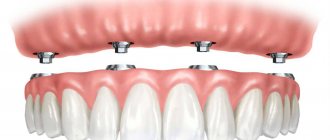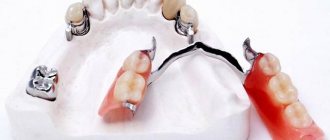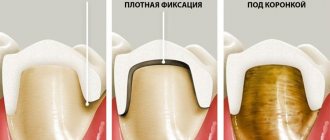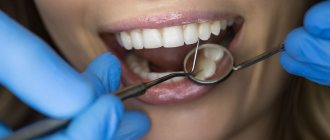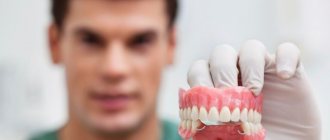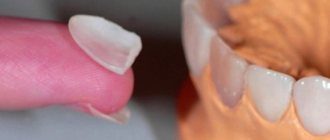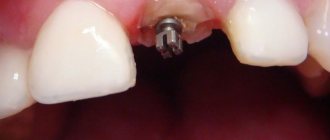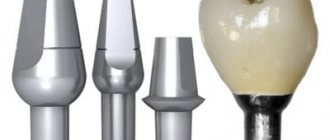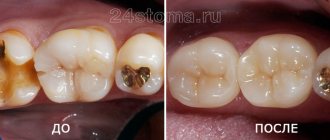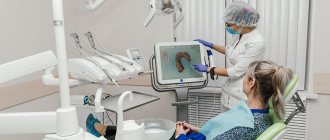The clasp prosthesis is a high-tech orthopedic design. It is made to order according to the individual parameters of the patient. This causes the technical complexity of creating such a prosthesis, which at times borders on jewelry craftsmanship. However, despite the individuality of production, any clasp prosthesis consists of the same elements. The shape of its design is revealed by the name itself: the word “bugel” is translated from German as “arc”. The arcuate metal element is considered the main part of the prosthesis. It is joined by so-called bases with artificial teeth. With the help of special fasteners, this structure is installed either on the palate, if prosthetics of the upper teeth is necessary, or under the tongue for prosthetics of the lower teeth.
Features of the clasp
A clasp denture is a conditionally removable structure that fully restores teeth and all their functions. It is fixed in the oral cavity to the supporting crowns in several ways: clasps, crowns, locks.
The prosthesis consists of a metal frame, a plastic base with artificial crowns. The frame consists of an arch, saddles (for crowns) and support-retaining components. The size and location of the arch depend on the defect in the dentition, the jaw, the shape of the alveolar process, the individual anatomical features of the patient’s oral cavity, and the condition of the mucous membrane. On the upper jaw it has a width of 8-10 mm and is flatter. On the bottom – 4-6 mm and semi-convex shape. This form ensures convenient use and quick adaptation to the design.
Due to the presence of the arch, the prosthesis has a very small base, the patient’s palate remains open - the taste and thermal perception of food is not disturbed. The prostheses are quite lightweight, but very durable and easy to use.
A big advantage is the possibility of using it for diseases of periodontal tissue and mobility. Unlike other structures, it does not loosen, but strengthens and splints the supporting teeth. The components of the structure correctly distribute the chewing load across the jaw. For high-quality clasp prosthetics, you need at least 5 healthy teeth for support.
Stages of prosthesis manufacturing
Making clasps is a long, step-by-step process. The device is created for each patient using casts of his jaws.
The stages of prosthesis manufacturing are divided into clinical and laboratory.
The clinical stage involves
- Examination of the patient. The condition of the oral cavity and dentition is analyzed, the type of occlusion is determined, support units are selected, and a schedule for eliminating the defect, if any, is drawn up. Installation of a prosthesis is carried out only after complete recovery of detected oral diseases.
- Preparation of supporting units for prosthetics;
- Taking impressions of jaws to make diagnostic and auxiliary models. Correction and identification of deficiencies is done during a trial fitting. Deficiencies are corrected in the laboratory;
- Final placement of the structure, checking balance.
After receiving the impressions, the specialist begins manufacturing the device. The stages of manufacturing a clasp prosthesis in laboratory conditions are as follows:
- A diagnostic version of the model is created from marble plaster. The specific structure of the patient’s oral cavity must be taken into account.
- The type of bite is modeled by correctly placing the jaws relative to each other. The pressure on the units that are planned to be used as reference is measured.
- The diagram of the future design is presented on the layout. The same model simulates the process of grinding teeth-supports.
- A model of the system frame is being developed, as well as its casting.
- Artificial chewing parts are placed on wax balls, and a row of restored teeth is formed from them.
- The resulting structure is placed in a plaster mold and melted. The wax is removed and an acrylic mass is poured in its place.
- All parts are combined into one structure. Grinding and polishing is carried out. The finished product is sent to an orthopedic dentist to be fixed in the patient’s mouth.
The process of adaptation to the prosthesis occurs without discomfort. The unusual sensations after the installation of the structure pass quite quickly.
Indications and contraindications for use
Clasp dentures are used for treatment in the following clinical situations:
- Dental defect in the anterior or lateral part of the jaw;
- Loss of several teeth in a row;
- Lack of teeth, which is combined with periodontal diseases, abrasion of dental tissues;
- Mobility;
- Unilateral or bilateral root defects.
Prostheses are not installed in the following cases:
- Absence of all teeth;
- Presence of less than 5 supporting teeth;
- Low height of clinical crowns;
- Poor hygienic care of the oral cavity;
- Severe periodontal tissue diseases;
- Acute inflammatory processes in the oral cavity;
- Dental diseases;
- Deep bite;
- Diseases of the temporomandibular joint;
- Allergy to materials used;
- Serious pathologies of the body;
- Period of exacerbation of diseases.
What is a clasp?
The clasp is a titanium, chromium-cobalt or gold-platinum frame in the shape of an arc with special fasteners. The main advantage of such dentures is their ability to rest not only on the gums, but also on the body of the jaw, palate, alveolar processes and healthy teeth.
Thanks to this design, the chewing load and pressure are evenly distributed over the entire dentition, preventing the process of loosening and premature loss of healthy teeth.
Nowadays, clasp prosthetics is becoming more and more in demand and popular.
This is due to a noticeable qualitative leap in the production of prosthetics. Modern clasps have a lightweight, durable, openwork design and practical fastenings that are invisible to prying eyes; they are durable, reliable and easy to use.
Fixation methods
The properties of the clasp, as well as service life, cost, and comfort of use depend on the method of fixation in the oral cavity. The dentist is faced with the task of reliably installing the structure so that it remains stable during functions - eating, talking. And also choose a fastener that will not have a negative effect on the teeth, gums, and mucous membranes.
Clasp fixation
The most affordable is the clasp denture. The elements are small but very durable hooks made of metal or plastic. The clasps cover the supporting crowns and thus securely hold the prosthesis. There are various support-retaining clasps, which differ in shape, type, and location.
The most important thing for high-quality prosthetics is to choose the right type of clasp. To do this, the dentist and technician carry out special methods for examining jaw models. The condition of the dentition, the number of missing teeth, the route of insertion of the prosthesis, the location of the defect and the boundary line, the presence of antagonist teeth, occlusal contacts, etc. are taken into account.
Clasps are a simple and reliable method. The disadvantage is the lack of aesthetics. In the anterior part of the jaw (in the smile area), the hooks may be noticeable.
Locking system
During the treatment process, special locks are used - attachments. The products consist of two parts - internal and external. One part is installed in the prosthesis, and the second in an artificial crown on the supporting tooth. When dressing, the mechanism clicks into place. Locks provide reliable fixation and stabilization of the structure by attaching to natural teeth, roots or implants. The method has many advantages:
- Excellent aesthetics;
- The castles are completely hidden from others;
- The smile looks beautiful and natural;
- Reliability and strength;
- Possibility to replace the lock;
- Long service life.
The disadvantage is the need to cover the supporting teeth with artificial crowns, strict requirements, complex manufacturing process, and relatively high cost.
- Telescopic crowns
The most aesthetic, high-quality and expensive treatment method is the use of clasp on telescopic crowns. The products are a special system of two crowns, one of which is placed on the supporting tooth, and the second is located in the frame of the prosthesis. These crowns precisely match each other and snap into place when the product is put on. Stabilization of the structure is ensured by the vertical walls of the crowns.
During use, chewing pressure is evenly distributed over the jaw, which prevents atrophy. Telescopic crowns are invisible to others, so the prosthesis is very aesthetic.
Beam fixation
Another reliable fastening method is the beam system. It consists of 2 parts: a fixed beam and a metal matrix in the prosthesis frame. The beam is attached to the crowns of the supporting teeth, and the matrix completely repeats the shape of the beam. When applying the clasp, the structure snaps into place, fixation and stabilization are ensured.
Types of clasps
Clasp-type structures are equipped with the following types of clasps, depending on the case:
- Supporting. Pressure distribution with such clasps is carried out on the mucous membrane and on dental supports.
- Retaining hooks. When the clasps settle, all the pressure falls on the mucous membrane
- Support-retaining clasps. Combines characteristics of both types
By shape and method of girth:
- With one or two arms, with one link, double, in the form of a ring
- Flat, tape
- Round or semicircular shape
By production:
- Molded (no elasticity)
- Bent (according to blanks)
Advantages and disadvantages
With high-quality prosthetics, taking into account all the individual characteristics of the patient, the clasp has many advantages:
- Excellent functional properties;
- Full restoration of functions;
- Strong fixation;
- Possibility of treatment in the absence of varying numbers of teeth;
- Possibility of prosthetics for diseases of periodontal tissues, mobility;
- Protection of periodontal tissue from unwanted load;
- Splinting;
- Elimination of horizontal pressure and proper distribution of chewing load;
- Support-retaining fixation elements prevent subsidence of the prosthesis;
- During use, prevention of alveolar ridge atrophy occurs;
- Possibility of prosthetics for location anomalies (tilting, rotation of teeth);
- Excellent fixation and stabilization;
- There is no need to prepare the abutment teeth;
- With the help of a prosthesis (onlays, splinting), you can change the height of the bite;
- Good aesthetics and appearance of the structure;
- The clasp takes up little space in the oral cavity;
- Tactile, taste or temperature sensitivity is not impaired;
- Quick habituation process;
- Simple hygienic care;
- Long service life;
- The prosthesis can be adjusted;
- The strong position of the clasp gives self-confidence to each patient, the use of the design is psychologically comfortable.
The disadvantage of the clasp is the complex manufacturing technology, which requires the skills of a doctor, special equipment, and materials from a dental technician.
Materials for clasp prosthesis
The materials used for the manufacture of clasp bridges can be divided into three groups: for the manufacture of frames, for bases, for dentures.
The first group includes metals (precious metal alloys, cobalt-chromium alloys, titanium) and plastics. Heat-treated acrylic plastic is used to make the bases. When a partial denture is made, the materials for the teeth allow you to choose the ideal option both in terms of aesthetics and in terms of economy - plastic, ceramics or metal can be used.
With the increase in allergic reactions to various metals and metal alloys used in medicine and dentistry, titanium is being considered as a crucial option.
High biocompatibility is due to the ability of titanium to form a protective oxide layer on its surface in a fraction of a second. Thanks to this layer, it does not corrode and does not release free metal ions that can cause pathological processes around the implants or bridge. Today, thanks to titanium, only one metal can be used in the oral cavity. Almost any design can be made. Titanium does not cause electrochemical reactions between different parts of the bridge, and the tissue surrounding the prosthesis remains free of metal ions.
How is prosthetics performed?
Prosthetics using a clasp design is quite lengthy and complex, but justified by excellent results. The first stage of treatment is a thorough clinical examination. The dentist conducts an examination, assesses the topography and size of the dentition defect, the condition and position of natural teeth. The type of occlusion, interalveolar distance, nature of teeth closure and other factors that may affect the success of treatment are determined. The patient is prescribed additional research methods (radiography, CT).
At the next visit, the specialist makes an accurate diagnosis and selects a suitable clasp prosthesis. The patient is informed about fixation methods and chooses the desired one. The dentist takes individual impressions of the jaws and passes them on to the dental technician.
In the dental laboratory, jaw models are cast, examined, and the future design is modeled. Several oral fittings are required during the manufacturing process. The finished structure is handed over to the dentist. The doctor tries on the prosthesis in the mouth and tells the patient how to put it on and take it off. Gives recommendations for use and hygienic care.
Components of the clasp
The simplest holding clasp consists of 3 parts - the shoulder, the body, and the appendage.
A more complex version, the support-retaining one, consists of a shoulder, an occlusal pad, a body and a process. This composition is typical for the classic type of support-retaining clasp called Akker.
The arm of the clasp is the part that holds it on the tooth.
The body of the clasp connects all the elements together.
The process or connecting rod is an element that coppers the prosthesis and the clasp itself. And the size of the process depends on the type of prosthetics.
And the foot or occlusal pad is a kind of transmitter of chewing force on the tooth at the level of occlusion.
Care
The clasp denture on the teeth must be removed periodically. Not every day, but 1-2 times a week, the product must be removed from the mouth and thoroughly cleaned.
You can take care of your teeth as usual – 2 times a day with a brush and toothpaste. After each meal you should rinse your mouth with water. Before going to bed, you should use a irrigator or clean the interdental spaces with floss. Every 6 months it is recommended to visit the dentist for professional hygiene, preventive examination of the prosthesis and oral organs.
We can conclude that clasp dentures are an excellent method of prosthetics. They perform all their functions and give a beautiful smile.
The best specialists from France
François Najjar: French Dental Clinic.
Chief physician, founder of FDC
Since 2004, the doors of the first exclusive French Dental Clinic in Russia have been opened for everyone who wants to have an appointment with famous specialists from Paris, Nice, Cannes, Sophia Antipolis, Lyon, Lille.
Specialists from all areas of dentistry were invited from different parts of France in order to undergo the most stringent selection. The choice fell on professionals with extensive experience of successful work and excellent recommendations.
— French Dental Clinic team
Frank Ajege
Periodontist-implantologist
Experience in surgical dentistry since 1987. Has a private clinic in Nice (France).
Michel Cassagne
Orthodontist
with over 30 years of experience in dentistry. Has a clinic in Paris, specializing in aesthetic orthodontics.
Didier Saada
Dentist
Experience in dentistry since 1988. Graduated from the Faculty of Surgical Dentistry at the Medical University in Marseille.
Stages of clasp prosthetics
Preparation of prosthetics
Preparation for clasp prosthetics begins with an examination of the patient. Doctors carefully listen to the patient’s complaints and wishes, conduct a dental examination, and study the patient’s medical history. After this, after analyzing the results of the examination, dentists decide on the need for clasp prosthetics.
Treatment of dental diseases
Before the production of the prosthesis begins, teeth that cannot be preserved are removed, periodontal disease and other dental diseases are treated. If there is a pronounced inclination of the abutment tooth or if there are restorations on it, as well as with prosthetics using telescopic or locking fixation, crowns are put on the abutment teeth.
